How to Avoid Spin Outs
By Dag Pike
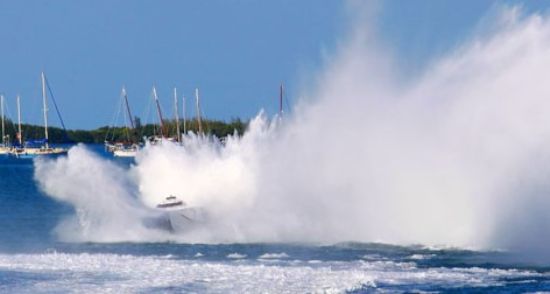
You can have a lot of exciting moments in a fast powerboat when things do not go quite according to plan. One of the most dramatic is a spin out, where the boat turns end for end or at least 90 degrees in the blink of an eye. If you are lucky, you can walk away from it. If not, it can also lead to tragedy. Hopefully, if you can understand why and how a spin out happens, then you can avoid this happening to you.
Steering Pull
The first cause is the one I learned about during my expert witness work for the courts. On older outboards and sterndrives, you will find a small fin attached to the lower side of the anti-cavitation plate that sits above the propeller. This fin is about 2 inches long and usually silver in color. It is there to counteract the tendency of a single outboard or stern drive to exert a steering pull to one side or the other, which can be tiring and potentially dangerous when driving.
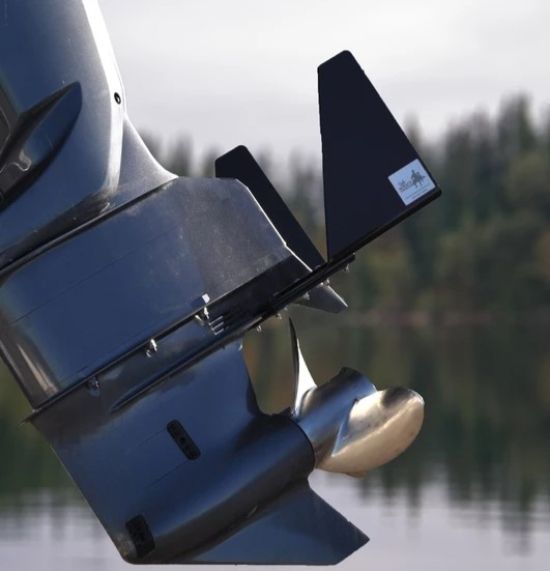
This steering pull is generated by the turning of the propeller, with the lower blades of the prop potentially in denser water than the top blades, which are close to the surface. This means that in effect the propeller is ‘walking’ sideways, creating the pull on the steering. This sideways thrust of the propeller can be counteracted by adjusting this trim fin, usually setting it between 5 and 10 degrees off-center. This exerts a steering correction and makes it possible to balance the steering so that there is minimal pull on the steering wheel. It stays more or less central when left to its own devices, making you feel more in control.
Small but Important. This sounds like a small point in making the driving of the boat more comfortable and less tiring. If not, adjusting this steering pull can also have disastrous consequences. A few years back, I was asked by an insurance company to look into an accident where the driver of a small fast boat that was towing a water skier lost control when the boat hit the wash of another boat and she was thrown away from the wheel.
She did not have the kill cord attached. So, left to its own devices, the boat turned sharply under full power or if you like it spun out, turning end for end and ran over the husband who was skiing behind, almost taking his arm off. The husband was a brain surgeon so the potential payout by the insurance company was up into the millions. My job was to see if the boat was seaworthy, which was one of the conditions of the insurance. This was a high-profile case that hit the headlines in a big way, as you can imagine.
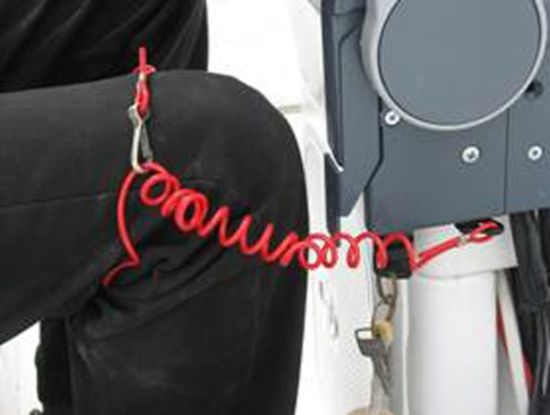
Of course, wearing a kill cord would have cut the engine immediately. The driver should have been connected but kill cords are not mandatory. The first thing I noticed with the boat was that the trim fin on the single outboard was on dead center with no adjustment. This meant that when I took the boat out on trials, there was a considerable pull on the steering wheel. When I simulated towing a water skier, I measured a pull at the rim of the steering wheel of over 20 pounds.
Quite a Difference
Now that would take some holding even under the best of conditions and be extremely tiring. When I had adjusted the trim fin, which is a simple job with a spanner, it was possible to eliminate most of that steering pull by adjustment, although the pull on the steering can vary with speed. So it is not possible to eliminate it. It was easy to see how that driver lost control when the boat hit the wake of another boat. Of course, the outboard would take control and swing hard over, causing the boat to spin out and the crew to be thrown across the boat, all for the lack of a small adjustment.
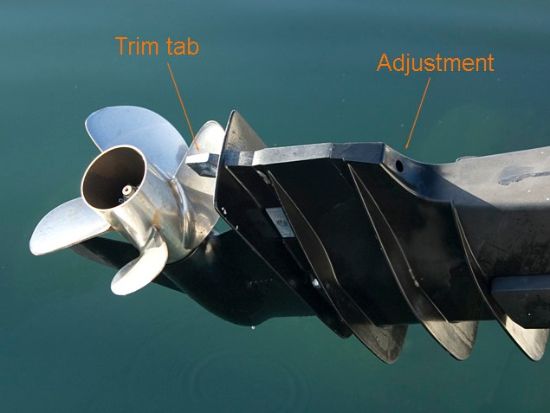
I judged that boat to be unseaworthy and the insurance payout was reduced dramatically. This is just one of several accidents I know about where an outboard-powered boat has spun out so that little trim fin is much more important than its size might suggest.
No More Feedback. On modern outboards that use fly-by-wire steering, the steering pull is still there at the transom. But there is no feedback to the steering wheel, so the trim fin has been eliminated and the boat is made safer. However, if your outboard has a trim fin then make sure it is adjusted correctly to avoid the danger of having a spin out in this way.
With twin outboards or stern drives, the propellers rotate in opposite directions, and so this steering pull is eliminated. Incidentally, this “walking” of single propellers can be used to advantage when maneuvering the boat in the harbor. The boat will tend to turn more readily to starboard because of the “walking” propeller, and this can be used to swing the stern into a jetty.
Speed-Related Spin Outs
The more dramatic type of spin out on a powerboat, which can sometimes be seen during powerboat racing, tends to occur when the boat is being driven as hard as possible when the driver is under some pressure to make the boat go as fast as the conditions will allow. When racing, a spin out will usually occur at a turning mark when the boat has to be turned through a considerable angle to take up a new course on the circuit. The standard mantra for racing boat drivers when turning a mark is either “wide in and close out” or “close in and wide out.” In other words, do not attempt to make the turn too sharply.
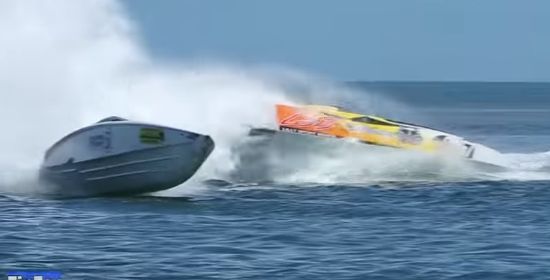
Don’t Close the Throttle. If you come into the turning point at too high a speed and you start to turn but find you are going too fast, then the natural reaction would be to close the throttle as the boat enters the turn. This seems like a logical thing to do but any experienced driver will know that closing the throttle will make the bow drop. This has the effect of moving the steering pivot point of the hull forward from its usual point on a racing boat close to the stern.
With the engine weight concentrated at the stern, the momentum of this weight will cause the stern to want to catch up with the bow as the pivot point moves forward and the spin out occurs with the boat turning end for end. There should be no harm done when you are sitting in the boat except to your pride and the boat should stay upright at the end of the spin, but the risk occurs when other boats may be in your vicinity on the racing circuit. This has been the cause of some tragic collisions. If you are standing, then there is a considerable risk of being thrown out.
Increased Risk?
I do wonder if the risk of a spin out is increased with many modern boats where there are three or four large outboards hanging on the transom. This is quite a weight hanging there right at the stern and so the momentum of that weight when the boat is turning could be considerable. Many of these boats are also based on stepped hulls and the risk of a spin out will be increased on a boat with a stepped hull where the boat will be riding on two or more points under the hull.
This means that the forward step could act as a pivot point for a spin, particularly when more weight is transferred to this forward step when the engine thrust is cut and the bow drops. I would assume that the same scenarios could occur with a catamaran, but I have no experience of this.
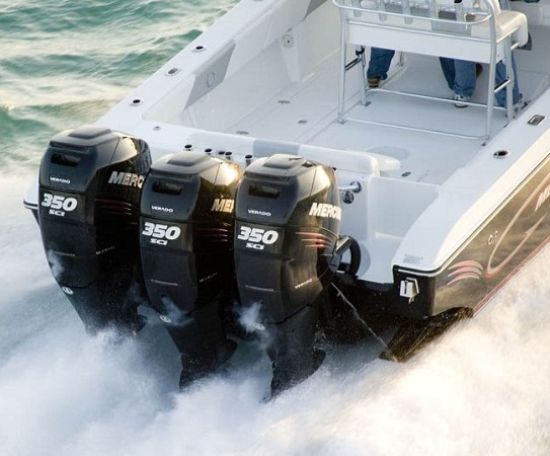
The solution to all this is to take care when turning at high speed or slow down before you turn. A high-speed turn can look and feel quite dramatic and exciting but do it at a constant speed and under full control.
Out of the Water
Another type of spin out can occur when the boat has dynamic steering, which is when the propeller thrust is used for steering as with outboards, stern drives, water jets, and some surface drives. When the boat leaves the water as often happens at high speed and then “flies” off the top of a wave and the propeller comes out of the water, any steering effect with this type of propulsion is temporarily lost. When the boat re-enters the water, the first part of the boat to re-enter will normally be the propeller which is likely to be still under power.
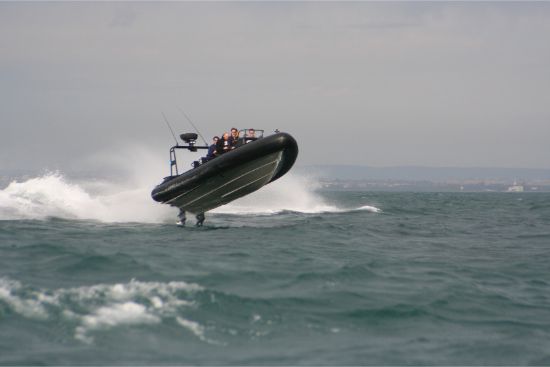
If the propeller thrust is angled to one side or the other from amidships there could be a brief period when that steering thrust has nothing to act against because the hull is still out of the water. This could put the boat into a dangerous situation of instability, and this is thought to be one of the primary causes of a spin-out in rough seas.
In theory, the same situation could occur with rudder steering. Because the steering effect is considerably less with a rudder, the chances of this happening are greatly reduced. The solution here is quite simple. First of all, drive the boat within its capabilities so that it does not leave the water. Secondly, do not attempt to turn the wheel when the boat is airborne.
Except in the first instance of the non-adjustment of the trim fin, a spin out is primarily caused by bad or over-enthusiastic driving. Bringing the throttle back a touch could take away much of the risk of a spin out. At the end of the day, the remedy is in your hands.